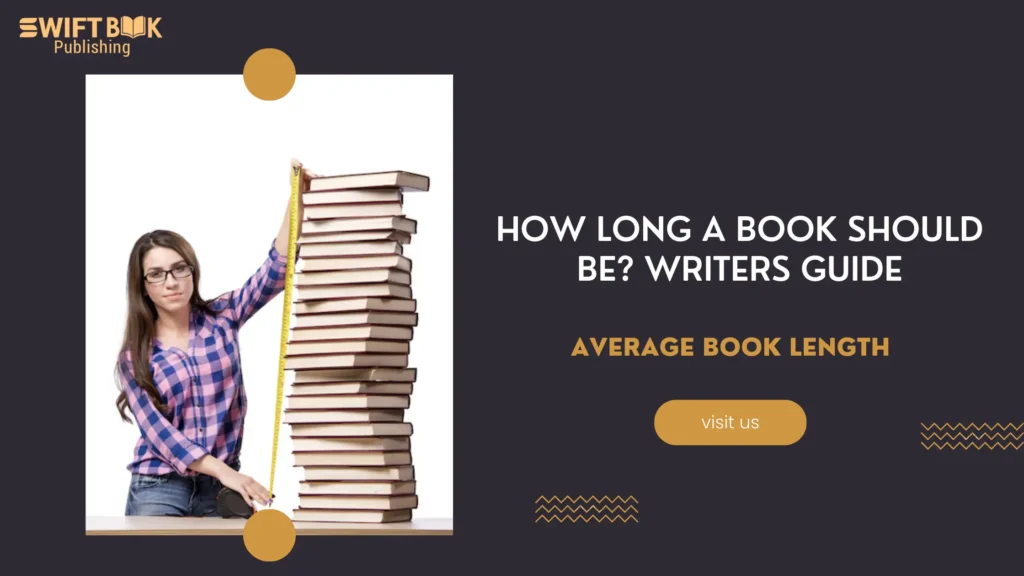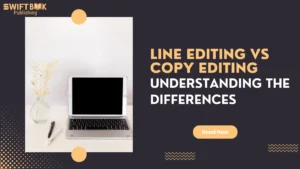How long should a book be? This question often troubles authors, especially those venturing into publishing for the first time. Whether you’re writing a novel or a non-fiction masterpiece, the length of your book plays a critical role in engaging readers, satisfying their expectations, and appealing to publishers.
Getting it wrong can have serious consequences. A book that’s too short might feel incomplete, leaving readers disappointed. On the other hand, a lengthy manuscript risks overwhelming your audience or appearing unmarketable to book publishers.
This guide answers the pressing question of average book length, providing detailed insights into word counts, page lengths, and physical dimensions. We’ll also explore how these factors differ between fiction and non-fiction, helping you craft a book that resonates with your audience and aligns with industry standards.
What is the Average Book Length?
Definition of Book Length
The term “average book length” can refer to multiple aspects:
- Pages: The number of pages varies depending on genre and formatting.
- Word Count: The most reliable measure, unaffected by design choices.
- Physical Dimensions: Length and width in inches or centimeters, especially relevant for physical books.
Why Book Length Matters
- For Publishers: A book’s length affects printing costs, marketability, and pricing.
- For Readers: The length sets expectations for depth, complexity, and time investment.
Key Statistics
- Fiction Books:
- Average length: 70,000–90,000 words (~250–350 pages).
- Exception: Fantasy and sci-fi often exceed 100,000 words (~350+ pages).
- Non-Fiction Books:
- Average length: 50,000–80,000 words (~180–300 pages).
- Variations depend on topic depth and audience needs.
Understanding these averages can guide your writing process, ensuring your book meets both reader and publisher expectations.
Fiction Books: Ideal Word Count and Page Length
Genre-Specific Averages
Fiction book lengths often depend on genre, with readers expecting specific ranges.
- Romance Novels:
- Word Count: 50,000–70,000 words.
- Page Count: 200–280 pages.
- Why: Romance stories tend to focus on character development and emotional arcs, requiring concise storytelling.
- Mystery/Thriller:
- Word Count: 70,000–90,000 words.
- Page Count: 250–350 pages.
- Why: These genres often involve intricate plots, requiring more detail to build suspense and resolve mysteries.
- Fantasy/Sci-Fi:
- Word Count: 100,000+ words.
- Page Count: 350+ pages.
- Why: World-building and complex narratives necessitate longer manuscripts.
Factors Influencing Length
- Story Complexity: Longer books allow for deeper plots, subplots, and character development.
- Reader Expectations: Genres come with unspoken rules about length—breaking them can alienate your audience.
- Market Trends: Publishers often favor standard lengths for better marketability.
Examples of Famous Novels
- The Great Gatsby by F. Scott Fitzgerald: ~47,000 words (~180 pages).
- Harry Potter and the Sorcerer’s Stone by J.K. Rowling: ~76,000 words (~320 pages).
- The Fellowship of the Ring by J.R.R. Tolkien: ~177,000 words (~423 pages).
These examples highlight how length varies even among bestsellers, depending on genre and purpose.
Non-Fiction Books: Average Length and Chapters
Typical Word Count and Page Range
Non-fiction books vary widely depending on their purpose and audience.
- Standard Non-Fiction: 50,000–80,000 words (~180–300 pages).
- Short Non-Fiction (e.g., guides, essays): 20,000–50,000 words (~100–180 pages).
- Comprehensive Non-Fiction: 80,000–120,000 words (~300–400 pages).
Common Topics and Lengths
- Self-Help Books: 50,000–70,000 words (~200–280 pages).
- Focus on practical advice and actionable steps.
- Biographies: 70,000–100,000 words (~250–350 pages).
- Offer detailed life stories with personal insights.
- Technical/Academic Books: 60,000–120,000 words (~200–400 pages).
- Provide in-depth analysis or instructions.
Chapter Length in Non-Fiction
- Non-fiction chapters typically range from 5 to 20 pages.
- Short Chapters: Common in self-help books for easy navigation.
- Longer Chapters: Used in biographies or academic books for in-depth discussions.
Let’s Compare Two Successful Books
- Atomic Habits by James Clear (~55,000 words): Compact, action-oriented self-help.
- Becoming by Michelle Obama (~130,000 words): A detailed, personal biography.
These examples showcase how book length varies based on intent and target audience.
The Impact of Word Count on Storytelling
Why Word Count Matters More Than Page Numbers
Focusing on word count rather than page numbers is essential for authors, especially those seeking professional publishing.
- Professional Formatting Influences Page Count: Page numbers can vary depending on font type, size, line spacing, and page dimensions. Word count, however, offers a consistent measure of content.
- Quality Over Quantity: Stretching a story unnecessarily can weaken its impact. A tightly written 70,000-word novel is more engaging than a bloated 100,000-word one.
Conversion of Word Count to Pages
Knowing how word count translates to pages helps authors visualize their book.
- Examples:
- 80,000 words in trade paperback format: Roughly 320–350 pages, depending on font and spacing.
- 80,000 words in hardcover format: Closer to 300 pages, as hardcovers often use smaller dimensions and denser formatting.
- Ebooks: Page counts can vary entirely based on the reader’s device settings.
How Word Count Shapes Storytelling
- Pacing: Word count determines how much room you have for plot development.
- Depth: Longer works allow for intricate subplots, while shorter pieces focus on concise storytelling.
- Reader Expectations: Genres like romance and mystery have established norms, where deviating significantly could deter readers.
By focusing on word count, authors can better control pacing, depth, and audience satisfaction.
Physical Dimensions: Length, Width, and Height
Standard Book Dimensions
Understanding the physical dimensions of books is vital for creating a product that aligns with market expectations.
- Trade Paperbacks:
- Dimensions: 5.5 x 8.5 inches (13.97 x 21.59 cm) or 6 x 9 inches (15.24 x 22.86 cm).
- Most popular format for novels and general non-fiction.
- Hardcovers:
- Dimensions: 6 x 9 inches (15.24 x 22.86 cm) or larger.
- Often used for premium editions, offering durability and prestige.
- Novellas and Pocket Books:
- Dimensions: 4.25 x 7 inches (10.8 x 17.78 cm).
- Compact, designed for affordability and portability.
How Size Impacts Perception and Marketability
- Larger Books: Often perceived as more authoritative or comprehensive, suitable for reference works and biographies.
- Smaller Books: Can appear more approachable, ideal for novellas and quick-read self-help guides.
Pro Tip:
Match your book size with your genre and audience. For instance:
- A compact size suits romance or travel guides.
- A larger format works better for fantasy, academic texts, or coffee-table books.
Read More: Swift KDP Book Sizes: Guide to Trim Sizes for Self-Published Authors
How Many Pages Should a Chapter Be?
Typical Chapter Lengths
The length of a chapter depends on the type of book and the author’s narrative style.
- Fiction Books:
- Average chapter length: 8–15 pages (~2,000–4,000 words).
- Shorter chapters create suspense, often used in thrillers. Longer chapters suit literary fiction or epic fantasies.
- Non-Fiction Books:
- Average chapter length: 5–20 pages (~1,500–5,000 words).
- Structured around topics or themes, with subheadings for easy navigation.
How Chapters Contribute to Overall Book Structure
- Fiction: Chapters drive the pacing, offering natural breaks for the reader.
- Non-Fiction: Chapters organize information, helping readers digest content and revisit key sections.
Balancing Brevity and Depth in Chapters
- Too Short: Can disrupt the narrative flow or make non-fiction feel underdeveloped.
- Too Long: Risks losing the reader’s attention or overwhelming them with information.
By ensuring chapters strike the right balance, authors can maintain engagement while delivering substance.
Genre-Specific Guidelines for Average Book Length
Children’s Books
The length of children’s books varies widely depending on the age group:
- Picture Books: Typically 1,000–2,000 words, relying heavily on illustrations.
- Early Readers: 2,000–5,000 words, with short chapters and simple sentences.
- Middle Grade: 20,000–50,000 words (~80–200 pages), with richer plots and character development.
Young Adult (YA) Books
YA novels usually range between 50,000 and 80,000 words (~200–320 pages).
- They often explore themes of self-discovery, identity, and relationships.
- Examples: The Hunger Games by Suzanne Collins (~100,000 words) leans toward the upper end for its genre.
Short Stories and Novellas
These formats cater to readers who prefer concise storytelling.
- Short Stories: 5,000–10,000 words (~20–40 pages).
- Novellas: 20,000–40,000 words (~80–150 pages).
- Novellas, such as The Strange Case of Dr. Jekyll and Mr. Hyde, often delve deeply into a single narrative arc.
Does Book Length Affect Sales?
Reader Preferences by Genre
Book length preferences vary based on genre and audience:
- Shorter Books: Favored in self-help and business genres, as they offer quick, actionable insights.
- Longer Books: Epic fantasies or historical fiction thrive on world-building and detailed storytelling.
Examples of Bestselling Books and Their Lengths
- The Great Gatsby by F. Scott Fitzgerald (~47,000 words) is a concise yet impactful novel.
- A Game of Thrones by George R.R. Martin (~300,000 words) exemplifies the appeal of epics.
Using Length Strategically for Market Positioning
- Authors can leverage shorter books to cater to readers looking for quick reads, such as novellas or niche non-fiction.
- Longer books may position the author as a comprehensive expert in their field or a master of detailed narratives.
Insight
Short books can dominate fast-paced genres like self-help, while longer formats often rule in fantasy or historical fiction, where immersive storytelling is critical.
Practical Tips for Determining Your Book’s Length
Determining the right length for your book is crucial for engaging readers, meeting industry expectations, and maximizing its marketability. Here’s how you can approach this thoughtfully:
1. Consider Your Target Audience
Your target audience’s preferences significantly influence your book’s optimal length.
Children and Young Adult (YA) Readers: These audiences gravitate toward shorter, more engaging books.
- Children’s Books: Depending on the age group, children’s books often range from 1,000 to 10,000 words. Illustrations also play a key role, reducing the need for lengthy text.
- YA Books: YA readers appreciate tightly woven narratives between 50,000 and 80,000 words, offering enough depth without overwhelming them.
Adult Readers: Adult readers are more receptive to longer, complex narratives.
- In genres like historical fiction or literary novels, books ranging from 80,000 to 120,000 words are common, as these genres rely on detailed world-building and intricate plots.
- Non-fiction for adults often varies widely but should balance in-depth content with digestibility.
By tailoring your book’s length to your audience’s preferences, you increase the likelihood of meeting their expectations and keeping them engaged.
2. Align with Genre Expectations
Each genre comes with its own standard word count and length conventions, which help set reader expectations.
- Romance Novels: Typically shorter, ranging from 50,000 to 70,000 words, allowing for concise storytelling and a focus on relationships.
- Science Fiction and Fantasy: These genres often push beyond 100,000 words due to their need for detailed world-building and complex plotlines.
- Mystery and Thriller: Generally range from 70,000 to 90,000 words to maintain suspense while resolving intricate plots.
- Non-Fiction: Length varies based on topic. Self-help books might be concise (30,000–50,000 words), while biographies or technical guides can exceed 100,000 words.
Research Tip: Analyze successful books in your genre to identify trends. For example, review page counts and word counts of bestselling books to gain insight into what resonates with readers. Aligning your book’s length with these trends ensures it feels familiar and market-ready.
3. Collaborate with Editors
Professional editors can be invaluable in determining the appropriate length for your book. Their expertise ensures that the content is neither overly drawn-out nor insufficiently developed.
- Streamlining Content: Editors can identify redundancies or areas where your story drags, helping you cut content without compromising the narrative.
- Enhancing Engagement: An editor can pinpoint where additional development is needed to maintain the reader’s interest.
- Balancing Word Count: They’ll ensure your manuscript aligns with genre standards and reader expectations, keeping the book polished and professional.
Working with editors not only helps refine your book but also ensures it’s the right length to appeal to your target audience.
Common Pitfalls to Avoid
- Overediting to Meet Word Count
Some authors fall into the trap of aggressively cutting content to hit a specific word count or page length. This can strip your book of its emotional depth or important details, leaving readers unsatisfied. Instead, focus on the quality of your storytelling over arbitrary numbers. - Ignoring Pacing
Pacing is a critical factor in maintaining reader interest. Rushing the narrative to stay within a word count can make the story feel incomplete, while adding unnecessary filler can frustrate readers. Balance is key:- Break up long sections with dialogue or action to keep the narrative dynamic.
- Avoid overly detailed descriptions or repetitive scenes that don’t move the plot forward.
By staying mindful of these pitfalls, you’ll create a book that’s well-structured, engaging, and appropriately tailored to your audience and genre.
Conclusion
Understanding the ideal length of your book is key to satisfying readers and meeting market standards. From aligning with genre norms to ensuring reader engagement, book length is as much about strategy as it is about storytelling.
While there are no strict rules, finding the balance between quality content and appropriate word count is essential. Whether your book is 200 pages or 500, prioritize storytelling and reader experience above arbitrary metrics.
Remember, a well-written book resonates with readers, regardless of its length.
Frequently Asked Questions
1. Is 250 pages too short for a book?
It depends on the genre. For romance or thrillers, 250 pages is common and acceptable. However, in genres like fantasy or literary fiction, it might seem too short for readers expecting more depth.
2. What length of book sells best?
Books between 200–350 pages (around 50,000–90,000 words) generally sell well. This range provides enough detail and engagement without overwhelming the reader, appealing to a broad audience.
3. Is 100 pages too short for a book?
Yes, 100 pages is too short for a traditional novel but fits for a novella or niche non-fiction. It can work if the content is highly targeted and well-structured.
4. Is 500 pages a long book?
Yes, 500 pages is considered long and is typical in epic fantasy or historical fiction. These genres often require extended narratives to explore detailed worlds or complex plots.
5. Does word count really matter?
Yes, word count significantly affects pacing, structure, and adherence to genre expectations. A well-balanced word count ensures the book feels complete and meets reader demands







